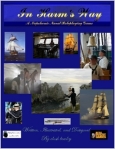A few years ago I watched the Hornblower series on DVD. Neat stuff about a guy named Hornblower that rises through the ranks in the British navy during the Napoleonic wars. I asked around, looking for games to model that series, and In Harm’s Way by Clash Bowley was mentioned a few times. Then I watched the Sharpe DVD series, and realized that I wanted my games to take place on land, and for that I already had Höstdimma. But still, In Harm’s Way had raised my interest, and when I did a Lulu order right before Christmas I put it in the basket.
Lulu took their time printing and shipping, so I didn’t get the game until after Christmas, but now I have read it and thought I’d share my opinions on the game.

In Harm's Way cover
The book
In Harm’s Way is 132 pages in US letter format. There are a few photo manipulations showing ships and men in period uniforms and sketches illustrating the layout of the insides of the ships.
The layout is simple and usually in a two column format, and large enough to be a nice read, and sometimes in single column with very long lines, not so fun to read. The game follows the old school of organization for the material (put stuff in the game in the order it was written), but there are both a table of contents and a register to ease finding specific information.
The setting
From the back cover:
In Harm’s Way is a roleplaying game about being a naval officer and a gentleman during the Napoleonic
In Harm’s Way is designed to emulate the feel of the historical naval adventures of Forester, O’Brian, Parkinson, Lambdin, Pope, and many others rather than the actual history. As such, it’s heavy on the adventure and romance, and light on the blockade and convoy duty.
The reader is expected to be familiar with the genre, but there are statistics for various kinds of vessels if a refresher is needed on the difference between a yawl and a launch.
There is a strong focus on doing stuff on a ship, mostly combat, as could be expected.
The rules
In Harm’s Way uses a modified StarCluster 2.5 system (Clash has written lots of games, those that fancy the system have games for a life time available.). I haven’t read any other games that use this system so I can’t tell which is standard and what has been modified, but at it’s core it is a BRP derivate. Roll a d100 under skill+modifier to succeed.
There are a few neat mechanisms in the rules that I have not seen before. Initiative is rolled with a d100, lowest acts first, but players can chose to adjust their initiative after rolling in exchange for bonuses or penalties to the following attack or damage roll.
The PCs track their Practicality and Honor scores, both start at ten, but they will fluctuate during play. The sum of them is always 20, as soon as one is increased the other must be decreased. Practicality and Honor can be added as a bonus on rolls that have to do with how practical or honorable the PC is.
The PCs have a stat called Luck, that is used like Fate in Höstdimma. Spend a point, say the key phrase and take over the narrative privileges from the GM for a short time. Not new to me as such, but it was fun to see that someone else had used the same idea in almost the same way.
The form
The form is traditional with GM and players, but with the troupe play twist. Each player can have multiple characters, their officer is the main, but they can also play a seaman and a warrant officer on the side. Useful if the party splits up to do different things at the same time.
Players compete against each other for Notice, who is the bravest or most capable officer? The winner will get promoted, leaving his old friends behind.
Conclusion
The setting is weak, but that should not be a problem if everyone is familiar with the genre.
The rules are good, but they only cover a narrow field of naval combat and competition between officers. Players that are looking for the romance mentioned on the back of the cover will have to play those parts without support from the rules.
The form is weak, if you already know how to play role playing games this is not a problem, you can take what is given and apply it to your own style. Little advice is given to the new GM on how to write adventures and run the game, or to the experienced GM on how to get the feel of the source material in the game.
Will I play it?
No, I don’t think so. This is a traditional game, and I find myself gravitating towards the story game part of the hobby. There are a few mechanics that I might steal if I go hacking a BRP game myself some day. Also, I still think adventures on land would be more interesting
—
http://www.flyingmice.com/ihw.html – Official In Harm’s Way page on Better Mousetrap Games




